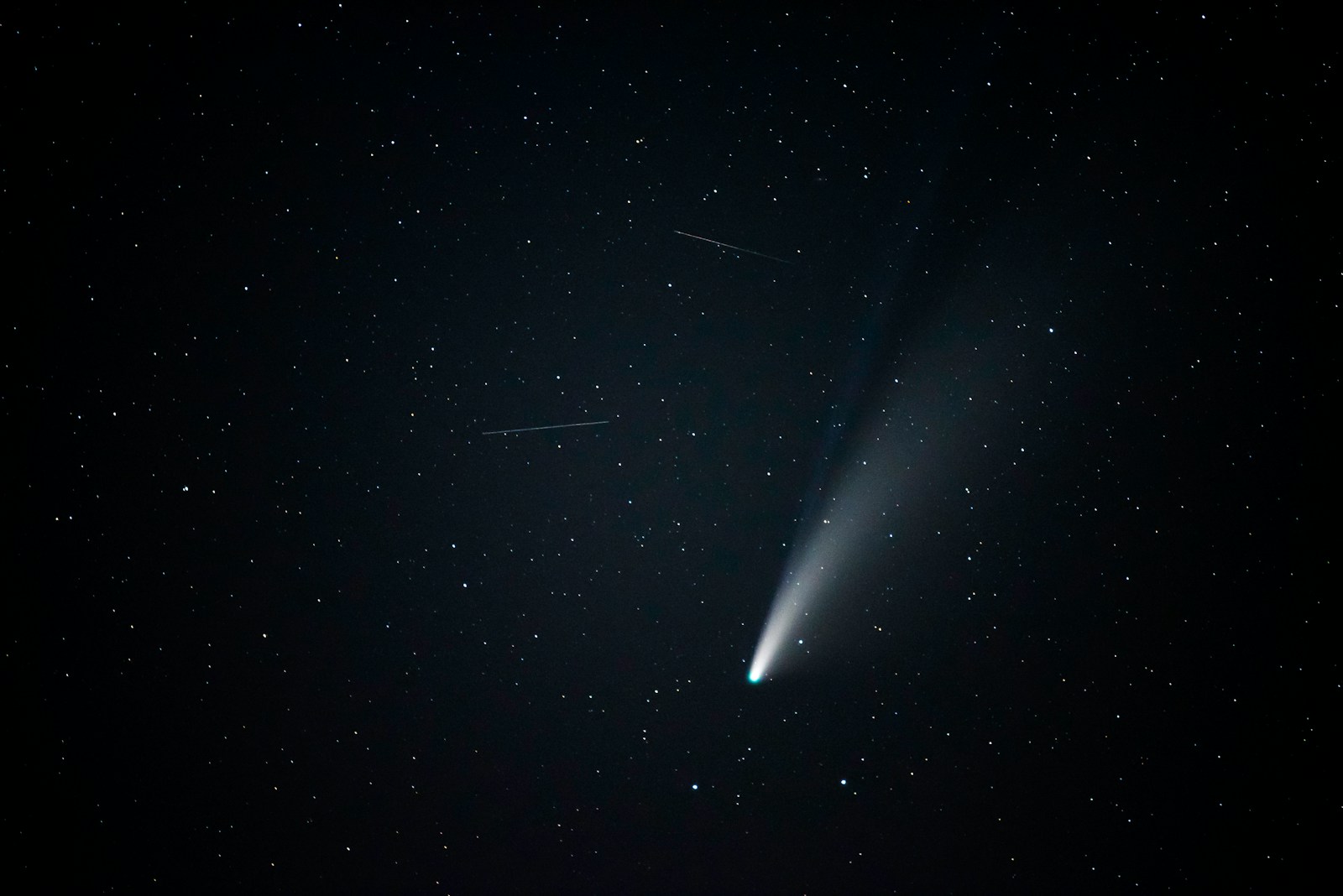Meteors and comets are both celestial objects that capture the imagination with their spectacular appearances in our skies. However, they are fundamentally different in composition, origin, and the ways they interact with Earth’s atmosphere. Let’s delve into the distinctions between these two astronomical phenomena.
Origin and Composition
Comets
Comets are often described as “dirty snowballs” because they are composed of ice, dust, and rocky material. They originate from the outer reaches of our solar system, primarily from two regions: the Kuiper Belt, which lies just beyond Neptune, and the Oort Cloud, a vast, spherical shell of icy bodies that surrounds our solar system’s outer limits.
As a comet approaches the sun, the heat causes its ice to vaporize and release gas and dust, forming a glowing head (coma) and often a tail that points away from the sun. The tails of comets are formed by the solar wind and radiation pressure, which separate the tail into two distinct parts: the ion tail, composed of gases, and the dust tail, made up of small, solid particles.
Case Study: Halley’s Comet
Halley’s Comet, perhaps the most famous of all comets, is a short-period comet visible from Earth approximately every 76 years. It originates from the Kuiper Belt and provides a striking example of a comet’s periodic return, fascinating astronomers and the public alike. Its last appearance in 1986 was observed by a global audience, demonstrating both the predictability and the majesty of these celestial travelers.
Meteors
Meteors, on the other hand, are the streaks of light we see in our atmosphere when a meteoroid (a small fragment of an asteroid or a comet) enters the Earth’s atmosphere and vaporizes due to friction. The term “meteor” refers to the flash of light (the shooting star), not the actual object. When these meteoroids enter Earth’s atmosphere, they travel at extremely high speeds, heating up and glowing brightly, creating the visible meteor. If a meteoroid is large enough to survive its fiery passage through the atmosphere and reach the Earth’s surface, it is then termed a meteorite. Unlike comets, meteoroids are composed mainly of rock and metal.
Example: The Chelyabinsk Meteor
The Chelyabinsk meteor that entered Earth’s atmosphere over Russia in 2013 serves as a dramatic example of a meteor event. It exploded with the force of approximately 470–500 kilotons of TNT, causing widespread damage and injuries, yet illuminating the night sky with a spectacular and terrifying light show. This event underscores the potential impact meteors can have when they enter our atmosphere.
Size and Visibility
Comets can be quite large, ranging from a few kilometers to tens of kilometers in diameter, and their tails can stretch for millions of kilometers. They become visible to the naked eye when they are near the sun, reflecting sunlight and sometimes being visible from Earth for weeks or even months.
Meteors, in contrast, are usually visible for only a few seconds as they burn up in the Earth’s atmosphere. The actual size of meteoroids can vary widely, but the ones that create visible meteors are typically the size of a grain of sand or a small pebble.
Practical Tip: Observing Comets and Meteors
For those interested in observing these celestial phenomena, a few practical tips can enhance the experience. Comets are best viewed with binoculars or a small telescope when they are close to the sun. Websites like NASA’s comet tracking service provide up-to-date information on when and where to look. For meteor showers, finding a dark location away from city lights during a peak shower event, such as the Perseids in August, offers the best chance for viewing multiple meteors per hour.
Orbits and Frequency
Comets have long, elliptical orbits that bring them close to the sun and then take them far back into the outer solar system. Some comets have short orbital periods of just a few years, while others might take thousands or even millions of years to complete an orbit.
Meteoroids that cause meteors come from a variety of sources. Some are debris from comets, creating meteor showers when Earth passes through their trails of dust and particles. Others are fragments from asteroids and have a more random distribution in our solar system.
Case Study: The Leonid Meteor Shower
The Leonid meteor shower, which occurs every November, is a prime example of Earth encountering comet debris. Originating from the comet Tempel-Tuttle, the Leonids can produce dramatic meteor storms in certain years, with hundreds or thousands of meteors visible per hour.
Interaction with Earth
While both comets and meteors provide fascinating celestial displays, they interact with Earth in different ways.
Comets
Comets are generally observed from a great distance and pose no direct threat to Earth. However, their debris can lead to meteor showers when our planet crosses through their paths. Understanding the trajectory and composition of comets helps scientists predict potential impacts and study the origins of our solar system.
Research Insight: Comet Impact Hypotheses
There are hypotheses suggesting that comet impacts may have brought water and organic compounds to Earth, potentially playing a role in the development of life. This theory is supported by the presence of amino acids and other organic molecules found in cometary material.
Meteors
Meteors, being smaller fragments, can occasionally reach the Earth’s surface as meteorites, offering valuable scientific insights into the composition of objects in our solar system but also posing a potential threat if large enough. For instance, the study of meteorites has provided clues about the early solar system’s conditions and the processes that led to the formation of planets.
Common Mistakes: Misidentifying Celestial Objects
One common mistake is confusing meteors with satellites or airplanes, which can also appear as moving lights in the sky. Satellites tend to move steadily across the sky without the bright flare of a meteor, while airplanes have blinking lights. A quick way to distinguish them is by observing the speed and brightness—meteors are typically much faster and brighter.
Cultural and Historical Significance
Throughout history, comets and meteors have been regarded with a mix of awe and fear, often seen as omens or portents. The appearance of a bright comet in the sky was sometimes interpreted as a sign of great change or disaster. Conversely, meteor showers have been celebrated in various cultures as celestial events of wonder.
Historical Example: The Bayeux Tapestry
The Bayeux Tapestry famously depicts Halley’s Comet appearing in 1066, an event that was seen as an omen for the Battle of Hastings. This intersection of celestial phenomena and historical events highlights how deeply intertwined human culture and the night sky have been.
Future Exploration and Study
With advancements in technology, the study of comets and meteors continues to evolve. Space missions, such as the European Space Agency’s Rosetta mission to comet 67P/Churyumov–Gerasimenko, have provided invaluable data about the composition and behavior of comets.
Future Missions: NASA’s DART and Beyond
NASA’s Double Asteroid Redirection Test (DART) mission, aimed at testing our ability to redirect a potentially hazardous asteroid, illustrates the growing importance of understanding and mitigating threats from celestial objects. While DART focuses on asteroids, similar techniques could one day be applied to comets or large meteoroids if necessary.
Summary
While comets and meteors both light up our skies, they are distinct in their origins, composition, and the way they interact with our planet. Comets are icy visitors from the distant reaches of the solar system, displaying spectacular tails as they approach the sun. Meteors, however, are brief and intense flashes of light caused by debris from space burning up in our atmosphere. Understanding these differences enriches our appreciation of these stunning natural phenomena and the vast cosmos in which they occur.
By exploring the history, science, and future potential of these celestial objects, we deepen our connection to the universe and broaden our understanding of our place within it. Whether observing a comet’s long journey across the sky or witnessing a meteor’s fleeting blaze, these experiences remind us of the beauty and mystery that the cosmos holds.




